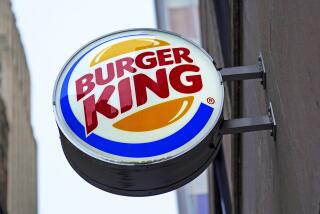Industry Fears Lawsuits More Than Clinton
- Share via
President Clinton’s plan to further curb tobacco sales is one more headache for the besieged industry but, as a financial threat, the rules are a sideshow to the menacing litigation facing the $45-billion business.
Experts said the prospect of expensive verdicts against the tobacco companies remains strong even though an Indiana jury late Friday decided in favor of the industry in a case brought by a smoker’s family.
“The real financial threat here [to the companies] is these lawsuits,” said John Maxwell Jr., an industry analyst at Wheat First Securities Inc. in Richmond, Va. “That’s what costs money.”
The new federal rules are not seen as a big danger to an industry experienced in maneuvering around advertising restrictions. Also, it is likely to be months, if not years, before the regulations take effect because the tobacco giants Philip Morris Cos. Inc. and RJR Nabisco Holdings Corp, along with other firms, plan to fight them in court.
Philip Morris and RJR Nabisco, maker of Winston and Camel cigarettes, termed the new rules unlawful but declined to elaborate on their financial impact.
Far more worrisome for the companies are the bevy of lawsuits and class-action claims that have been filed against the cigarette makers by smokers or their relatives.
The industry has never paid damages in 45 years of such litigation. But earlier this month a jury in Jacksonville, Fla., awarded a smoker and his wife $750,000 in a case against Brown & Williamson Tobacco Corp. The jurors saw company documents linking nicotine and addiction that were not available to the Indiana jurors.
*
The Florida case is being appealed. If it’s upheld, there is speculation it could expose the tobacco companies--which are generally in strong financial shape--to untold damage awards.
The new tobacco regulations--if ever implemented--would reduce the companies’ eroding marketing reach even further, forcing them to invent new ways of promoting cigarettes and smokeless tobacco.
The rules also would crimp some magazine publishers, a few professional sports, billboard operators and others that partly depend on tobacco advertising dollars.
But predictions varied as to how the rules would affect the amount spent on tobacco advertising.
The advertising industry said they threatened $1 billion in revenue and could cost thousands of jobs. But Time Inc., publisher of Time, People and Sports Illustrated magazines, said it saw nothing in the rules to prevent it from continuing to accept cigarette ads because the magazines aren’t aimed at youngsters.
Even if most tobacco advertising dries up, the impact on magazine publishers and outdoor advertising firms would be minimal. The Magazine Publishers Assn. said tobacco advertising amounted to $317 million, or 3% of the industry’s revenue, in 1995.
The billboard industry has been moving away from tobacco for nearly 20 years, imposing voluntary restrictions on ads within 500 feet of schools, playgrounds and churches. Cigarette advertising accounted for 8% of its revenue in 1995, down from 39% in 1979.
Meanwhile, tobacco companies have been exploring alternative ways of reaching consumers. Philip Morris plans to launch a glossy lifestyle magazine this fall that will be distributed free to 1.5 million smokers listed in the company’s database. The firm is also said to be considering its own chain of private smoking clubs.
“These marketers are some of the best in the world,” said Ken Harris, a partner with the Cannondale Group, a consulting firm. “They will find new venues, clearly targeted to adults, staying one step ahead of the regulators.”
Besides using their highly sophisticated databases to reach consumers via direct mail, Harris said that cigarette companies are likely to focus on advertising that uses their corporate name and image--which is still permitted--and pump money into magazines that are clearly aimed at adults.
The new tobacco rules limit ads in publications with a “significant” youth readership, defined as 2 million young readers or 15% of total readership. But making that determination may not be easy, as publishers generally do not track readers younger than 18.
“If a TV Guide or a People is on a coffee table, and children pick it up and look at it, publishers have no information on that, and it is probably an invasion of privacy to obtain information on that,” said Magazine Publishers Assn. President Don Kumerfeld.
Some people in the advertising industry think the criminal and civil penalties for violating the rules will dissuade publishers from accepting tobacco ads.
“This is a ban in sheep’s clothing,” said John Kamp, senior vice president of the American Assn. of Advertising Agencies. “I think you will see very little cigarette advertising.”
Kamp and representatives of the outdoor advertising industry said the new restrictions on billboard advertising will effectively eliminate outdoor tobacco ads from urban areas.
Though ads would be permitted in rural areas, tobacco companies are unlikely to do so because such ads would have to appear in black-and-white and contain text only.
*
While the rules may reduce or eliminate tobacco ads, they won’t affect cigarette usage, marketers said. Kamp said cigarette smoking increased despite advertising restrictions in such countries as Sweden, Norway, Finland, Italy and the former Soviet Union.
“The great laboratories of the countries of the world show us that bans do not affect the consumption rate,” he said.
Kamp said the advertising restrictions would have the effect of “freezing market share” because smokers would be less likely to try new brands without being enticed by advertising.
Marketing consultant Harris also ventured that the restrictions could backfire by making forbidden cigarettes more alluring to children and teenagers looking for a way to rebel.
“I think there will be a reverse spin, partly due to the stigma that smoking has attached to it. You’re seeing that in the increase that is occurring now. Younger people think it’s cool. The more restrictive it gets, the cooler it becomes,” he said.
* TOBACCO VICTORY
Jury in Indiana cancer death trial rules in favor of cigarette firms. D1
More to Read
Inside the business of entertainment
The Wide Shot brings you news, analysis and insights on everything from streaming wars to production — and what it all means for the future.
You may occasionally receive promotional content from the Los Angeles Times.











